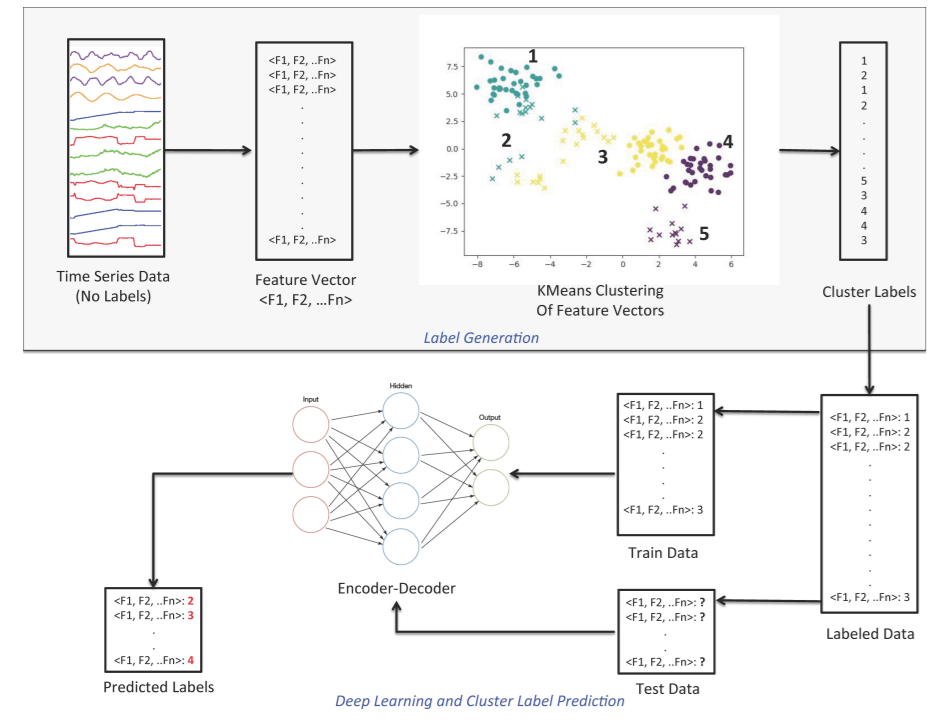Clustering Time Series Data through Autoencoder-based Deep Learning Models (2020)
Contents
- Abstract
- Introduction
- Literature Review
- t.s. Representation methods
- t.s. Similarity/Distance Measures methods
- t.s. Cluster Prototypes
- t.s. Clustering Algorithm
- Feature Vectors of Time Series as Data Labels
- Common general components of t.s data
- A Synergic method for t.s Clustering
- Stage 1 : Label Generation
- Stage 2 : Autoencoder-based Clustering
0. Abstract
Clustering = optimization problem & iterative process
goal :
- MAXIMIZE the similarities of data items &
- MINIMIZE the similarities of data objects grouped in separate clusters
heavily depends on dimension ( = number of features to be considered )
\(\rightarrow\) identification of hidden features!
This paper introduces…. TWO-stage method for clustering TIME-SERIES data
-
step 1) utilize the characteristic of given time series data
\(\rightarrow\) create LABELS ( make it as SUPERVISED learning )
-
step 2) autoencoder-based DL
- learn & model both the known/hidden features of t.s.data
1. Introduction
Challenges with TSC (Time Series Clustering)
- 1) Unlabeled data
- 2) High dimensionality
- 3) Hidden features
Contributions
- 1) two-stage methodology ( introduction 참고하기 )
- 2) case study performed on clustering time series data of 70 stock indices
2. Literature Review
TS clustering = 3 main categories
-
[1] Whole time-series clustering
- cluster a set of individual time-series
-
[2] Subsequence clustering
-
only performed on a single time-series
-
single time-series is divided into multiple segments
-
-
[3] Time Point clustering
-
only performed on a single time-series
-
not required to assign all points to clusters
( = some can be noise )
-
This paper reviews only [1] Whole time-series clustering
Whole time-series clustering = 3 different approaches
- 1) shape-based
- 2) feature-based
- 3) model-based
Whole time-series clustering = 2 categories
( w.r.t the length of time series )
- a) shape-level
- b) structure-level
a) shape-based approach
- based on shape similarity
- matched using a non-linear stretching
- conventional clustering methods
b) feature-based approach
-
key : feature extraction
-
(1) transform the raw time-series into the set of features
( + dimensionality reduction )
-
(2) then, use conventional clustering algorithm in lower dimension
c) model-based approach
-
assume a model for each cluster
( & fit the data into the assumed model )
-
each raw t.s data is transformed into either..
- 1) model parameters ( = one model for each t.s )
- 2) mixture of underlying probability distn
Whole time-series clustering’s 4 major components
- 1) dimensionality reduction
- 2) distance measurement ( similarity )
- 3) clustering algorithm
- 4) prototype definition & evaluation
(1) t.s. Representation methods
dimensionality reduction
- 1) reduces memory requirements
- 2) speeds up
4 types of t.s representation methods
- 1) data adaptive :
- minimize the global reconstruction error
- 2) non-data adaptive
- only appropriate for t.s with FIXED-size
- 3) model-based
- represent t.s in a stochastic way
- ex) HMM, statistical models, ARMA
- 4) data-dictated ( clipped data )
- feature reduction ratio is automatically defined according on raw time-series
- ex) clipping (bit-level) representation
(2) t.s. Similarity/Distance Measures methods
2 categories of similarity/distance measure approaches
-
1) clustering according to objectives
-
similarity in time/shape/change
-
(time)
- similar t.s are discovered on each time step
- calculated using RAW t.s …… expensive
-
(shape)
-
similar shape, regardless of time points
( similar trends, at different time : OK )
-
ex) DTW (Dynamic Time Warping)
-
-
(change)
- = structural similarity
- 1) t.s data is first modeled using modeling methods ( ex. HMM, ARMA…)
- 2) then similarity metric is measured, based on global feature extracted
- appropriate for long time-series
-
-
2) clustering according to the length of time-series
- shape level : for short-length
- structure level : for long-length
(3) t.s. Cluster Prototypes
3 main methods to obtain cluster prototypes
-
1) Medoid prototype
-
defined as member of cluster,
such that its dissimilarities to all other members in the cluster is minimum
-
-
2) Averaging prototype
- mean of time-series at each point
- used when time-series have equal length ( DTW (X) )
-
3) Local Search prototype
- step 1) medoid of cluster is computed
- step 2) warping paths techniques are used to calculate average prototype
(4) t.s. Clustering Algorithm
- 1) hierarchical
- 2) partitioning-based
- 3) density-based
- 4) grid-based
- 5) model-based
- 6) multi-step based ( = hybrid )
3. Feature Vectors of Time Series as Data Labels
(1) Common general components of t.s data
- 1) seasonality
- 2) cycle
- 3) trend
- 4) irregular features
4. A Synergic method for t.s Clustering

(1) Stage 1 : Label Generation

(2) Stage 2 : Autoencoder-based Clustering

